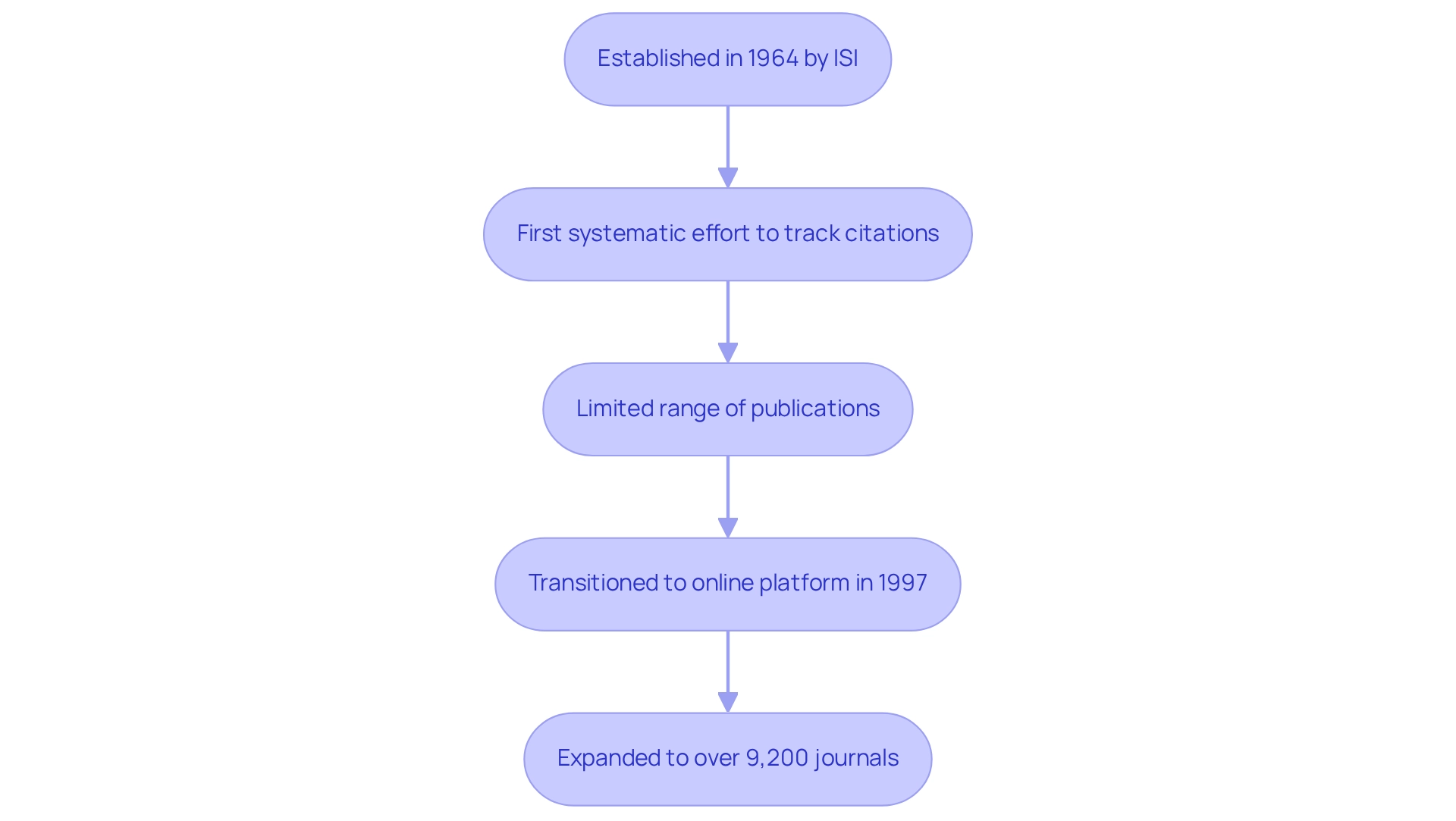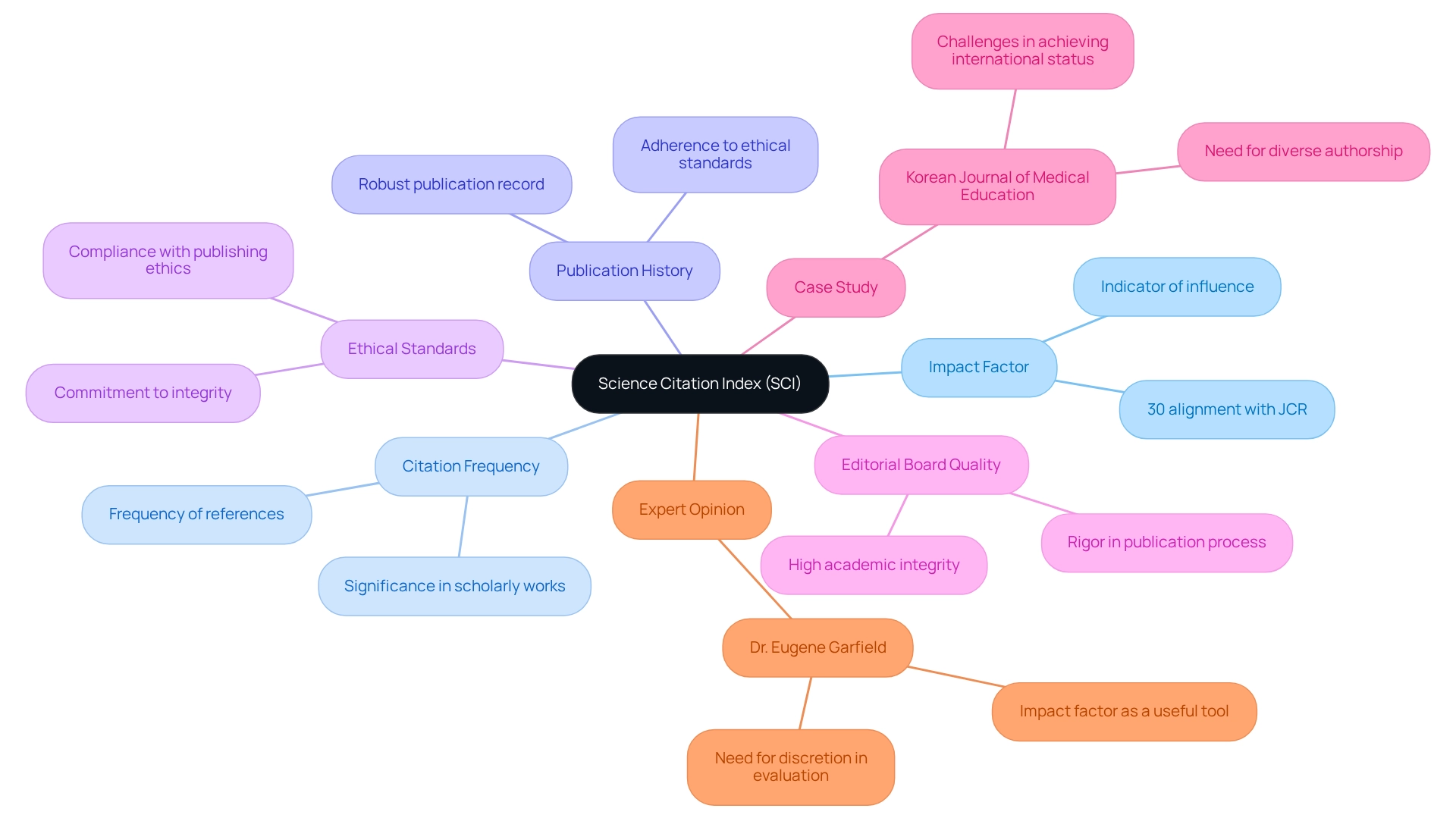Overview
The Science Citation Index (SCI) stands as a pivotal citation index, meticulously tracking and monitoring citations of research articles. This function is essential for evaluating scholarly influence and facilitating the flow of ideas across diverse disciplines. Established in 1964, the SCI has significantly expanded, indexing thousands of journals. This extensive reach provides researchers with indispensable tools for assessing the impact of their work, thereby enhancing the visibility of scientific literature. Its rigorous selection criteria and historical significance within the academic community underscore its vital role in scholarly evaluation.
Introduction
In the realm of scientific research, the Science Citation Index (SCI) serves as a cornerstone, meticulously cataloging the citations of scholarly articles across a multitude of disciplines. Established in 1964 by Eugene Garfield, the SCI has fundamentally transformed how researchers evaluate the impact of their work and trace the flow of ideas within the scientific community. This comprehensive index not only enhances the visibility of research but also plays a critical role in funding decisions and academic evaluations.
As the landscape of research continues to evolve, grasping the significance of the SCI becomes essential for navigating the complexities of scientific inquiry and collaboration. This article explores the historical context, key characteristics, and the profound importance of the SCI in shaping the future of research.
Define Science Citation Index (SCI)
What is the Science Citation Index (SCI)? It is an essential citation index that meticulously monitors citations of articles published in research journals. Established by Eugene Garfield in 1964 and currently maintained by Clarivate Analytics, the SCI serves as a vital tool for researchers to track how frequently their work is cited by peers. This capability not only facilitates the evaluation of scholarly influence but also enhances the understanding of the flow of ideas across various disciplines.
The SCI covers a broad spectrum of scientific fields and indexes thousands of journals, providing a comprehensive overview of the scientific literature and its interconnectedness. As highlighted by a 1980 study, citation indexing has long been recognized for its benefits, particularly in fields like chemistry, where it allows for the observation of subfields over time.
In the context of data-driven insights, it is crucial to remember the words of Arthur Conan Doyle: ‘It is a capital mistake to theorize before one has data.’ This underscores the significance of robust data in citation tracking and the visibility of studies, akin to how CareSet examines over $1.1 trillion in yearly Medicare claims data to provide unmatched insights into treatment trends and patient demographics.
Furthermore, case studies illustrate how effective citation indexing can significantly enhance the visibility of scholarly work, making the SCI an indispensable resource for academic inquiry.
Explore the Historical Context of SCI
Established in 1964 by the Institute for Scientific Information (ISI), the Science Citation Index (SCI) is a pioneering initiative spearheaded by Eugene Garfield. This groundbreaking index fundamentally transformed the landscape of scholarly research by providing a systematic method for tracking citations across literature, addressing a previously labor-intensive and inefficient task.
As Eugene Garfield noted, “Nearly 50 years ago, I published what is science citation index, which was the first systematic effort to track citations in scientific literature.” Initially, the SCI encompassed a limited range of publications; however, its reach has significantly expanded over the years. By 1997, the index transitioned to an online platform, greatly enhancing accessibility for researchers worldwide.
Today, the Science Citation Index represents an integral component of the Web of Science Core Collection, which includes the Science Citation Index Expanded (SCIE), now featuring over 9,200 actively publishing journals across diverse disciplines. This evolution underscores the vital role of the Science Citation Index in improving the visibility and influence of scholarly work, reflecting its historical importance in the academic community.
Vitek Tracz, publisher of Faculty of 1000, described Garfield as “a genius of a very special type,” emphasizing the tenacity and courage that propelled the development of citation indexing. Furthermore, ISI’s role in the research community has been pivotal, as it extends and enhances the knowledge base for researchers, government organizations, and corporations through its reports and publications.
This historical context highlights the enduring influence of the Science Citation Index on scientific inquiry and its significance in the academic landscape.

Identify Key Characteristics and Criteria of SCI
What is the Science Citation Index? It is characterized by its stringent selection criteria for publications, encompassing several critical factors. Foremost among these is the publication’s impact factor, which must align with at least 30% of the Journal Citation Reports (JCR) in its respective category. This metric serves as a vital indicator of a publication’s influence and reach within the scientific community. Additionally, citation frequency plays an essential role, indicating how often articles from the publication are referenced in other scholarly works, further underscoring its significance.
Journals aspiring to be indexed in the SCI must also exhibit a robust publication history and adhere to ethical publishing standards. The quality of the editorial board is another crucial criterion, ensuring that the publication maintains high academic integrity and rigor. The SCI’s comprehensive coverage of cited references allows users to trace the impact of specific articles and authors, providing valuable insights into the evolution of scientific discourse.
Moreover, the SCI offers advanced tools for citation analysis, enabling researchers to evaluate the impact of their contributions and identify emerging trends in their fields. For instance, the Korean Publication of Medical Education faced challenges in attaining international status due to a high proportion of single-country authors. To enhance its recognition, the publication must diversify its authorship, illustrating the importance of broadening contributions to meet SCI criteria. This case study exemplifies the broader implications of publication selection criteria, highlighting how adherence to these standards can significantly influence a publication’s standing in the academic community.
Expert opinions emphasize the significance of the impact factor in citation indexing. Dr. Eugene Garfield, the creator of the Institute for Scientific Information, observed, “The impact factor is a highly beneficial tool for assessing publications, but it must be used judiciously.” This perspective reinforces the need for a balanced approach when evaluating publication quality, underscoring the importance of discretion in utilizing impact factors.
In summary, the Science Citation Index (SCI) can be characterized by rigorous selection criteria, a focus on impact factors and citation frequency, and a commitment to ethical publishing practices. Journals that meet these standards not only enhance their visibility but also contribute significantly to the progress of knowledge in the sciences. The upcoming essay will present examples of how to effectively utilize evaluation tools, further enhancing the comprehension of these essential metrics.

Discuss the Importance of SCI in Research
The Science Citation Index (SCI) plays a pivotal role in the scientific ecosystem, serving as a reliable metric for assessing the impact of scientific work. It empowers researchers to identify influential studies, track citation trends, and discover potential collaborators. By indexing high-quality journals, the SCI significantly boosts the visibility of studies, enabling authors to reach a wider audience. This visibility is crucial for funding organizations and academic institutions, which rely on SCI data to evaluate scholarly performance and make informed decisions regarding resource allocation.
In 2025, the importance of the SCI for funding agencies is further highlighted by its influence on funding policies and academic recruitment strategies. The index not only showcases successful studies but also reveals areas requiring focused funding, as evidenced by trends in biomedical funding. For instance, while overall funding has risen, certain subfields still encounter challenges, indicating a need for strategic interventions. The duplicate rate for scientists in the RePORTER database, which ranges from 5% to 6%, underscores the credibility and reliability of scholarly outputs indexed by the SCI.
Moreover, the SCI’s comprehensive citation data bolsters evidence-based decision-making, which is essential for fostering scientific advancement. As Brené Brown noted, the appeal of quantitative studies lies in their clarity; however, the depth of qualitative insights is equally vital. This duality is reflected in the SCI’s impact on both funding decisions and collaborative initiatives, fostering a more equitable and efficient environment for inquiry. Marie Curie’s assertion that “science has great beauty” enriches this discussion by emphasizing the intrinsic value of scientific inquiry beyond mere metrics.
Real-world examples illustrate the SCI’s influence on performance assessments. Organizations leveraging SCI data can more effectively evaluate their output and impact, leading to improved funding opportunities and collaborative ventures. The SCI not only enhances the credibility of research but also plays a crucial role in shaping the future of scientific inquiry. The imperative for a thoughtful redesign of future funding agendas to enhance equity and efficiency is a critical consideration that the SCI can help address, ensuring that funding is directed where it is most needed. Specific findings from the case study titled “Trends in Biomedical Research Funding” reveal that while overall funding has increased, certain subfields continue to struggle with low funding rates, highlighting the necessity for targeted funding strategies.
Conclusion
The Science Citation Index (SCI) serves as a foundational pillar in the scientific research landscape, meticulously tracking citations and enhancing the visibility of scholarly articles across diverse disciplines. Established in 1964 by Eugene Garfield, the SCI has transformed from a modest index into an expansive resource that encompasses thousands of journals, reflecting its critical role in academic and research communities. This historical significance, marked by a commitment to rigorous selection criteria and ethical publishing practices, underscores the importance of data-driven insights in evaluating scientific influence.
Key characteristics of the SCI, such as its focus on impact factors and citation frequency, facilitate the assessment of individual research contributions while also helping to identify emerging trends and potential collaborations. As funding agencies increasingly rely on SCI data for informed decision-making, the index becomes instrumental in shaping research policies and enhancing the credibility of academic institutions. The ability to monitor citation trends and assess research impact is vital for fostering a collaborative and equitable research environment.
Ultimately, the SCI transcends being merely a citation index; it is an essential tool that informs the future of scientific inquiry. By continuously adapting and expanding its reach, the SCI plays a pivotal role in ensuring that quality research is recognized and supported. As the research landscape evolves, understanding and leveraging the SCI will be critical for researchers, institutions, and funding bodies alike, paving the way for a more informed and impactful scientific community.


